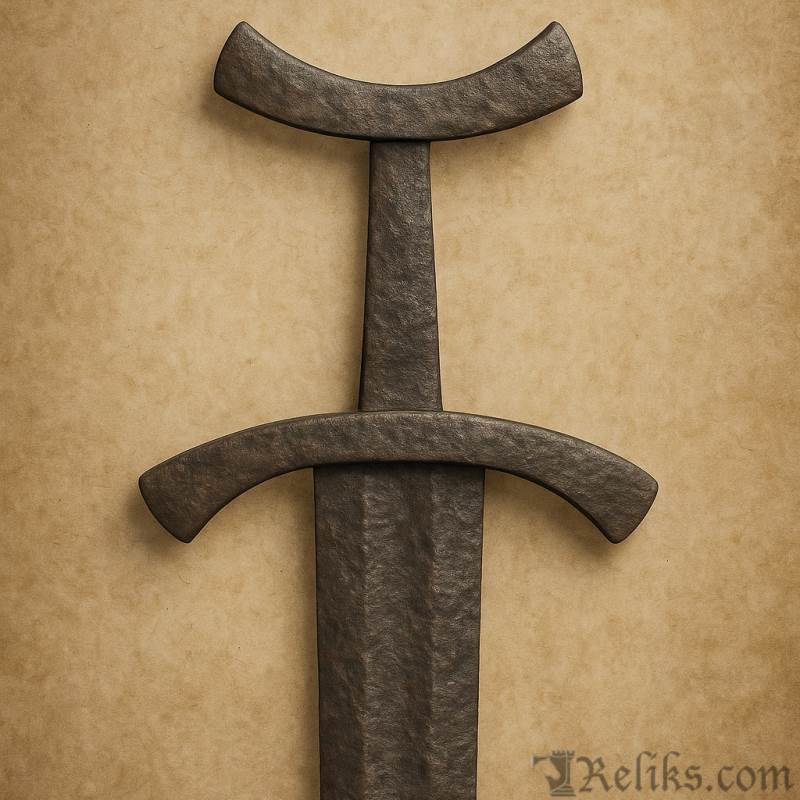Viking Sword Type Æ — The Last of the Viking Swords
A Sword at the Edge of Two Worlds
Type Æ stands as one of the youngest Viking sword forms, a weapon that bridges the twilight of the Viking Age and the dawn of the medieval period. Unlike the bold lobed pommels of earlier centuries, these hilts sweep into elegant curves. The upper guard rises in a gentle arc with no separate pommel at all, while the lower guard bends downward in a mirror image. Together, they form a flowing, bow-like silhouette that looks strikingly modern compared to the heavy, decorated swords of the 9th century.
To hold a Type Æ is to glimpse the end of an era: a Viking weapon shaped by centuries of tradition, yet already adopting the simpler lines of the knightly arming swords that would soon dominate Europe.
Archaeological Description

Viking Sword Type Æ – The Last Viking Sword
The defining feature of Type Æ is the absence of a pommel. Instead, the upper guard is extended upward, curving across the top of the grip. The lower guard mirrors this motion, dipping downward, sometimes sharply at the center. Both guards broaden at the ends, and their cross-sections are slim, narrow, and pointed—built for utility rather than display.
Decoration is absent. These hilts lack the silver sheathing and inlays of earlier prestige swords. What remains are plain surfaces, functional and unadorned, reflecting a culture shifting away from swords as luxury status symbols and toward swords as practical tools of war.
The blades are always double-edged, fitted with narrow, deep fullers. No inscriptions or pattern-welded examples have yet been identified among the Norwegian finds.
Distribution & Finds
Petersen documented around 16 Norwegian examples, with the majority concentrated in Hedmark and Oppland in eastern Norway. Smaller numbers appear in Buskerud and Akershus, but the inland dominance is striking. This geography makes sense: burial with weapons lasted longer in these upland valleys than on the coast, giving us a clearer archaeological window into the period’s final decades.
Beyond Norway, a handful of parallels exist in Sweden (notably Gestrikland), suggesting that this late sword fashion extended across eastern Scandinavia.
Dating & Context

Petersen (fig.138)
Type Æ belongs securely to the late 10th and early 11th century. Finds often include:
- M-type spearheads and M/L-type axes, pointing firmly to a younger horizon.
- Shield bosses of type R 565 or later, as well as the latest rattle-rings.
- One notable sword from Halsteinshov (Loiten, Hedmark) carries a downward spur projecting from the lower guard, a feature clearly aligned with continental medieval sword-building methods.
Together, these traits prove that Æ was used right on the threshold of the Middle Ages, overlapping with the youngest X, Y, and Z types.
Historical & Cultural Significance
By c. 1000 CE, the Viking Age was entering its final act. Norway was transforming into a Christian kingdom, and the heroic raiding ethos was giving way to more organized armies and political consolidation. Yet in Hedmark and Oppland, men were still laid to rest in pagan-style graves with their swords.
Type Æ swords reflect this moment of transition. They strip away the pomp of earlier hilts, leaving a simple, curved design that feels almost austere. These weapons anticipate the straight, functional arming swords of the High Middle Ages. In them, we see both the last Viking swords and the first medieval swords—a hybrid form that perfectly embodies the end of one world and the beginning of another.
Closing Reflection
Type Æ is more than just another entry in Petersen’s typology. It is a marker of time itself. These swords tell us that the Viking Age did not end abruptly but faded into the medieval era with continuity as well as change. In their clean lines and absence of ornament, they speak to a new martial reality—one in which swords were still carried, but less as treasures and more as battlefield companions.
If Type H once symbolized the confident opening of the Viking Age, then Type Æ represents its quiet close. Standing at the crossroads of pagan and Christian, Norse and continental, these hilts embody the transformation of Europe at the year 1000.
Core classification based on Jan Petersen, De Norske Vikingesverd (1919). Additional commentary by Reliks.com.